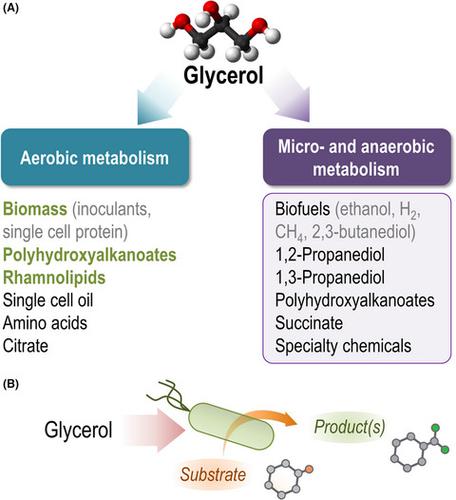当前位置:
X-MOL 学术
›
Microb. Biotechnol.
›
论文详情
Our official English website, www.x-mol.net, welcomes your feedback! (Note: you will need to create a separate account there.)
Biochemistry, genetics and biotechnology of glycerol utilization in Pseudomonas species.
Microbial Biotechnology ( IF 5.7 ) Pub Date : 2019-03-18 , DOI: 10.1111/1751-7915.13400 Ignacio Poblete-Castro 1 , Christoph Wittmann 2 , Pablo I Nikel 3
Microbial Biotechnology ( IF 5.7 ) Pub Date : 2019-03-18 , DOI: 10.1111/1751-7915.13400 Ignacio Poblete-Castro 1 , Christoph Wittmann 2 , Pablo I Nikel 3
Affiliation

|
The use of renewable waste feedstocks is an environment‐friendly choice contributing to the reduction of waste treatment costs and increasing the economic value of industrial by‐products. Glycerol (1,2,3‐propanetriol), a simple polyol compound widely distributed in biological systems, constitutes a prime example of a relatively cheap and readily available substrate to be used in bioprocesses. Extensively exploited as an ingredient in the food and pharmaceutical industries, glycerol is also the main by‐product of biodiesel production, which has resulted in a progressive drop in substrate price over the years. Consequently, glycerol has become an attractive substrate in biotechnology, and several chemical commodities currently produced from petroleum have been shown to be obtained from this polyol using whole‐cell biocatalysts with both wild‐type and engineered bacterial strains. Pseudomonas species, endowed with a versatile and rich metabolism, have been adopted for the conversion of glycerol into value‐added products (ranging from simple molecules to structurally complex biopolymers, e.g. polyhydroxyalkanoates), and a number of metabolic engineering strategies have been deployed to increase the number of applications of glycerol as a cost‐effective substrate. The unique genetic and metabolic features of glycerol‐grown Pseudomonas are presented in this review, along with relevant examples of bioprocesses based on this substrate – and the synthetic biology and metabolic engineering strategies implemented in bacteria of this genus aimed at glycerol valorization.
中文翻译:

假单胞菌种中甘油利用的生物化学,遗传学和生物技术。
使用可再生废物原料是一种环境友好的选择,有助于降低废物处理成本并增加工业副产品的经济价值。甘油(1,2,3-丙三醇)是一种广泛分布于生物系统中的简单多元醇化合物,是生物过程中使用的相对便宜且易于获得的底物的主要示例。甘油已广泛用作食品和制药行业的一种成分,也是生物柴油生产的主要副产品,多年来导致底物价格不断下降。因此,甘油已成为生物技术中有吸引力的底物,假单胞菌具有丰富而丰富的新陈代谢,已被采用来将甘油转化为增值产品(从简单分子到结构复杂的生物聚合物,例如聚羟基链烷酸酯),并且已经采用了许多代谢工程策略来增加甘油作为具有成本效益的底物的应用数量。这篇综述介绍了甘油生长的假单胞菌的独特遗传和代谢特征,以及基于该底物的生物过程的相关实例-以及针对该属细菌实现的针对甘油增值的合成生物学和代谢工程策略。
更新日期:2019-03-18
中文翻译:

假单胞菌种中甘油利用的生物化学,遗传学和生物技术。
使用可再生废物原料是一种环境友好的选择,有助于降低废物处理成本并增加工业副产品的经济价值。甘油(1,2,3-丙三醇)是一种广泛分布于生物系统中的简单多元醇化合物,是生物过程中使用的相对便宜且易于获得的底物的主要示例。甘油已广泛用作食品和制药行业的一种成分,也是生物柴油生产的主要副产品,多年来导致底物价格不断下降。因此,甘油已成为生物技术中有吸引力的底物,假单胞菌具有丰富而丰富的新陈代谢,已被采用来将甘油转化为增值产品(从简单分子到结构复杂的生物聚合物,例如聚羟基链烷酸酯),并且已经采用了许多代谢工程策略来增加甘油作为具有成本效益的底物的应用数量。这篇综述介绍了甘油生长的假单胞菌的独特遗传和代谢特征,以及基于该底物的生物过程的相关实例-以及针对该属细菌实现的针对甘油增值的合成生物学和代谢工程策略。



























 京公网安备 11010802027423号
京公网安备 11010802027423号